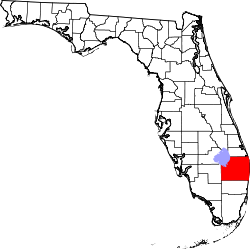
Back مقاطعة بالم بيتش (فلوريدا) Arabic مقاطعة بالم بيتش، فلوريدا ARZ Condáu de Palm Beach (Florida) AST Palm-Biç (dairə) Azerbaijani Palm Beach County, Florida BAR Палм Бийч (окръг) Bulgarian পালম্ বীচ কাউন্টি, ফ্লোরিডা BPY Palm Beach Gông (Florida) CDO Палм-Бич (гуо, Флорида) CE Palm Beach County CEB
Palm Beach County | |
|---|---|
 | |
| Coordinates: 26°43′N 80°03′W / 26.71°N 80.05°W[1] | |
| Founded | April 30, 1909 |
| County seat | West Palm Beach |
| Largest city | West Palm Beach |
| Area | |
• Total | 6,170 km2 (2,383 sq mi) |
| • Land | 5,100 km2 (1,970 sq mi) |
| • Water | 1,070 km2 (413 sq mi) |
| Population | |
• Total | 1,492,191 |
• Estimate (2022)[3] | 1,513,301 |
| • Rank | 26th in the United States 3rd in Florida |
| • Density | 296.61/km2 (768.17/sq mi) |
| GDP | |
| • Total | $117.543 billion (2022) |
| Time zone | UTC−5 (Eastern Time Zone) |
| • Summer (DST) | UTC−4 (Eastern Daylight Time) |
| Website | www.co.palm-beach.fl.us |
Palm Beach County is a county in the southeastern part of Florida, located in the Miami metropolitan area. It is Florida's third-most populous county after Miami-Dade County and Broward County and the 26th-most populous in the United States, with 1,492,191 residents as of the 2020 census.[2] Its county seat and largest city is West Palm Beach, which had a population of 117,415 as of 2020.[5] Named after one of its oldest settlements, Palm Beach, the county was established in 1909, after being split from Miami-Dade County. The county's modern-day boundaries were established in 1963.
Palm Beach County is one of the three counties that make up the Miami metropolitan area, which was home to 6.14 million people in 2020. The area has been increasing in population since the late 19th century, with the incorporation of West Palm Beach in 1894 and after Henry Flagler extended the Florida East Coast Railway and built the Royal Poinciana Hotel, The Breakers, and Whitehall. In 1928, the Okeechobee hurricane struck Palm Beach County and caused thousands of deaths. More recently, the county acquired national attention during the 2000 presidential election, when a controversial recount occurred.
In 2004, Palm Beach County was Florida's wealthiest county, with a per capita personal income of $44,518.[6] It leads the state in agricultural productivity; agriculture is Palm Beach County's second-largest industry, after real estate development.[7] In undeveloped (central and western) Palm Beach County there is significant tropical agricultural production, especially nurseries, truck crops (vegetables), and sugar cane.[8] Palm Beach County has been called the "Winter Vegetable Capital" of the nation.[9]
- ^ "2018_gaz_counties_12.txt". census.gov. 2018.
- ^ a b "P2: HISPANIC OR LATINO, AND NOT ... - Census Bureau Table". P2 | HISPANIC OR LATINO, AND NOT HISPANIC OR LATINO BY RACE. U.S. Census Bureau. Retrieved June 21, 2023.
- ^ "County Population Totals and Components of Change: 2020-2022". County Population Totals: 2020-2022. U.S. Census Bureau. June 21, 2023. Retrieved June 21, 2023.
- ^ "Gross Domestic Product: All Industries in Palm Beach County, FL". fred.stlouisfed.org.
- ^ "Find a County". National Association of Counties. Retrieved June 7, 2011.
- ^ "Florida Fun Facts Q&A". The Palm Beach Post. Archived from the original on March 6, 2012. Retrieved October 18, 2008.
- ^ Scott W. Barnhart; Alan W. Hodges (March 28, 2016). Economic Contributions of Agriculture, Natural Resources and Food Industries in Palm Beach County, Florida (PDF) (Report). Prepared for the Palm Beach International Agricultural Summit. p. 18, figure 7. Direct output of major industry groups in Palm Beach County, Florida, 2014. Archived from the original (PDF) on June 11, 2016. Retrieved May 11, 2016.
- ^ Susan Salisbury (May 10, 2016). "How a relatively small amount of acreage feeds a lot of people". Palm Beach Post. Archived from the original on August 12, 2016. Retrieved May 11, 2016.
- ^ C. Spencer Pompey (2003). More Rivers to Cross. West Palm Beach: StarGroup International. p. 183. ISBN 1884886086.



